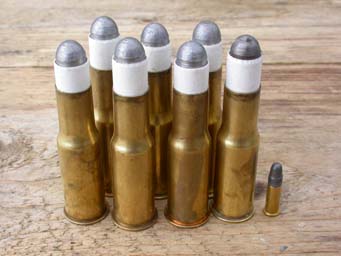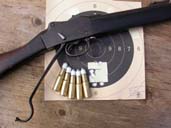Forum
Market
- Tennhetteverktøy berdan
- Fjeder søges til Smith & Wesson 44-40 DA Frontier
- Johan F. Støckel - Haandskydevaabens bedømmelse. Bind 1–2.
- Gammel pistol
- Steyr kropatschek
- diesett i 12,17x44R
- Hagle til salgs
On this day
2 December 1983
The Norwegian Black Powder Union (Norsk svartkruttuion) was founded in Trondheim. The founding fathers were Ivar Edvard Grimstad, Ragnar Hegge, Raymond John Sivertsen and Nils Ove Rutlin. Ragnar Hegge is the only survivor of the four, and as of... Read more ...
Norsk svartkruttunion was founded
The Norwegian Black Powder Union (Norsk svartkruttuion) was founded in Trondheim.
The founding fathers were Ivar Edvard Grimstad, Ragnar Hegge, Raymond John Sivertsen and Nils Ove Rutlin. Ragnar Hegge is the only survivor of the four, and as of today he is still active black powder shooter.
To create publicity for the union it was decided to write an article about black powder shooting for the Norwegian magazine Våpen , along with some pictures. The Union’s main intention was to:
"… coordinate and safeguard the interests of black powder shooters – and to be a national and international liaison."
Today the Norwegian Black Powder Union is a member of the international MLAIC.

Chat
Offline
No chatting right now.
(You must be logged in to the forum to chat.)
Featured article

The Martini-Henry rifle was the British military service rifle from the end of the 1880\'s. It served on all continents and was a powerful and reliable rifle. This article is the first part in a series of two on the Martini-Henry rifles. This part deals about the background history of the Martini-Henry rifles.
.577/.450 Martini-Henry Rifles - Part 1
.577/.450 Martini-Henry Rifles - Part 2
 About
AboutPublished: 24 November 2007 by Øyvind Flatnes.
Edited: 25 November 2007.
Views: 99488
 Les artikkel på norsk
Les artikkel på norsk
Seven Martini-Henry cartridges and a .22 LR cartridge for comparison.
Loading black powder in metallic cartridges seems to be more and more popular here in Norway. The black powder cartridges are for many shooters the gate that leads to a membership in the Norwegian Black powder Union. The following article has its focus on the practical use of the old British infantry rifle, the .577/.450 Martini-Henry.
Find out more!
You can read more about the British Martini-Henry and Snider rifles, as well as other early breech-loading single-shot rifles in the brand new book From Musket to Metallic Cartridge: A Practical History of Black Powder Firearms.
My Martini-Henry rifle was bough very cheap at an internet auction not long ago. It is a Mk. IV with the long lever, which means it was probably not used by the British Army, but by some of their native troops in one of the colonies. It was made by the RSAF in Enfield in 1887, which indicates that it was one of the many .402" calibre Enfield-Martini rifles that was later converted to .577/.450 Martini-Henry rifles. The Mk. IV was not being made before 1888, but quite a lot of the Mk. IV's are stamped with both 1886 and 1887 on the right side of the receiver. All of these are converted .402" Enfield-Martinis. I soon discovered markings on my rifle pointing me in the direction of Nepal. On the rear sights I found the markings that revealed were the rifle had been used: N.E.P. and N.S. The latter initials means 'Native Service' and N.E.P. indicates 'Nepal'.
Thousands of Martini-Henry rifles were sold from Britain to Nepal during the last part of the 1800's. Nepal was never a British colony, but came under British influence after 1815. The background for this was that Nepalese Ghurkha soldiers invaded Northern India in 1814 and the British counterattacked with five armies shortly after. Four of the armies were annihilated, but the fifth managed to force themselves into Nepal, marched through the Katmandu Valley which brought them near to the Nepalese capital. The king of Nepal chose to negotiate for peace and shortly after a peace treaty was signed. The British were now allowed to cross Nepal to trade with Tibet. They were also allowed to enlist Ghurkha soldiers for the British Army. After having wiped out four of the five British armies, these soldiers had gained themselves enormous respect. Even today the British Army enlist Ghurkha troops.
The two American companies Atlanta Cutlery and International Military Antiques bought several thousands Brown Bess, Enfield rifle muskets, Sniders and Martini-Henry rifles from Nepal in 2003. Most of them had been stored for over hundred years. Many of these arms are in fairly good condition, but there are also weapons that are in lousy shape and can't be shot. My rifle had a chip of wood missing from the butt and a little chip missing from the forestock, but was otherwise in good shootable condition. The bore was very good but the muzzle was of course a bit worn. A crowning fixed that. The old rifle was disassembled down to the smallest screw and the mechanism was bright and shiny on the inside. I removed a lot of old military storage grease which had protected the steel well.Bullets and brass
If you are to shoot your Martini-Henry you have to be ready to do some preparations. You have to get hold of bullets and brass, and that's not the simplest thing in the world. I got brass directly from Bertram Bullets in Australia. They are high quality drawn cases and the cost was 4.40 AUD a piece. You can also get them from the British firm Kynamco.


Home swaged Martini-Henry bullet and bullet for
.45-70 Gvt.To the right: A .577/.450 Martini-Henry
cartridge and a .22 LR cartridge for comparison.
The first shots
The brass cases from Bertram were too tight at the muzzle and the .470" paper patched bullet was too big for the case. Instead I used a 405 grain .457" Lee bullet to fire form the cases. The accuracy was lousy but the cases expanded a bit and after this operation they could take the larger bullets. I haven't shot the rifle much yet, but I have used Fg and FFg Wano black powder loads in the 85-80 grain range. At fifty metres (55 yds) I managed to set five bullets in a 1.8" group from the bench. Four of the shots were in a 1.2" group but the fifth shot was a flyer. Not perfect, but absolutely something to work with! The load was 80 grains of FFG and I used some toilet paper as wadding to prevent any air gap in the case. Then I loaded a card wad and a .24" thick grease cookie of beeswax and pig lard and a card wad over that again.Movie Clips (.wmv files)


Click to see movies:
Loading the .577/.450 Martini-Henry
(2 Mb).
Shooting the .577/.450 Martini-Henry
(814 Kb).





